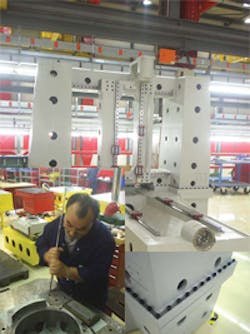Accuracy Drives Machine Tools
Mori Seiki has officially expanded its manufacturing capabilities beyond mainland Japan with its grand re-opening of Dixi Machines. Dixi, of Le Locle, Switzerland, now is a division of Mori Seiki International SA.
The plant represents Mori Seiki’s first production facility outside of Japan, and the company said it will help it to serve the European market and to meet demand for higher accuracy and faster cutting machine tools.
Dr. Masahiko Mori, president of Mori Seiki, said he expects that accuracies of 0.1-micron and cutting speeds that are five to six times faster than are currently achievable will be the norm for commercially available machine tools by 2015.
Dixi machines are in the high-end market and have a reputation for precision and accuracy. Mori Seiki plans to use the facility to further develop ultrahigh-end machine technology that it will also apply to its middle-sector machine tools to meet the tolerances and speeds that Dr. Mori spoke of.
Accuracy drives all aspects of Dixi machines, and building such machines requires a special facility. For example, the plant’s temperature is held to within +/- 0.2 degrees C, and temperatures in some areas within the facility are controlled even closer. Dixi controls its metrology center temperature to +/- 0.03 degrees C, and the room rests on a concrete floor supported by a huge spring system to eliminate outside vibrations that could skew measuring results.
The company claims that its machines are so accurate that they machine parts correctly the first time, without any trial cutting.
Dixi reports 3D volumetric accuracies of 15 microns for its fouraxis machines, and 25 microns for its five-axis models.
Several factors contribute to the high accuracy of Dixi machines. Heavy duty ribbed machine base castings sit on three-point support systems that make installations easy. More importantly, the company said its three-point support systems eliminate twisting and reduce the need for re-leveling its machines. Box-inbox designs with dual drives prevent machine column rock and make for moving a lighter mass with even driving forces. Tightly spaced bolts secure machine upper structures to machine beds to create a mono block.
According to Mori Seiki, static and dynamic rigidity of Dixi machines can run as much as three times better than that of standard machine tools because of the way that Dixi machines are manufactured.
Hand scraping contributes significantly to Dixi machine accuracy. On average, more than 500 hours of hand scraping goes into each machine. All mating surfaces and mounting surfaces for glass scales are handscraped.
To thwart the negative affects of heat on machine accuracy, Dixi actively cools machine components that generate heat to keep them at a consistent temperature. In addition, the company mounts stainless steel shields or liners that keep coolant and hot chips away from machine castings.
Contrary to a long-held notion that a Dixi was for precision part finishing only, the machines’ spindles pack high torque and high horsepower for rough, semi rough and finishing cuts, all in one setup. The spindles are coupled to their motors, and main spindle bearings feature vibration, temperature, pressure and expansion sensors.
Spindle bearings are put under a variable pre-load that automatically adjusts to the spindle rpm. That provides rigidity and accuracy when the spindles run at high rpm and eliminates vibration at low rpm.
Dixi makes a line of jig boring machines that includes the JIG 700, 700 5x, 1200, and 1200 5x, and high-production machines such as the DHP 50, 50 5x, 80, and 80 5x.
Both machine types use the same bases and columns, and theoretically, the only difference between them is that the production machines have pallet changers.
Shops can choose 4-axis, 5-axis, or 5-axis with tilt table versions of both JIG and DHP machines, and a 6-axisversion DHP that has an automatic work changer.
